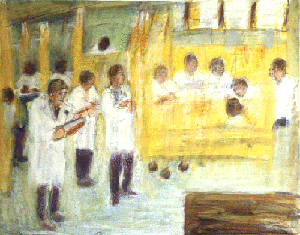'Teaching Rounds at Charity'
(ink drawing with tempera and pastel, 22' x 30')
©May H. Lesser
Apart from the computer programs and standardized patient/actors, used in medical school teaching, the human contact still remains as the basis for healing. When the physician is called upon to see more and more patients, quickly, he reaches a saturation point. There is still a human frailty that one can only encompass a certain number of people before one "turns off." Could the emphasis on the mechanical procedures draw the doctor away from human feelings about his patients? And being seen quickly in large numbers, will the patient also lose human compassion for his physician?
Last Reviewed: May 11, 2012



